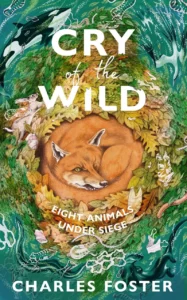Recently published by Doubleday, the stories of Charles Foster’s ‘Cry of the Wild’ — a modern twist on the likes of Watership Down and Tarka the Otter — reveal the complexity, beauty and fragility of wild lives. Sue Brooks reviews.

Tarka the Otter has been much in my mind recently. I read it as a child and ever since have been unable to manage more than the first few pages. The last chapters, written and rewritten over four years by Henry Williamson, have haunted my imagination, knowing the terrible brutality that waited there.
Ted Hughes said of Tarka, at the memorial service for Henry Williamson in 1977, that it was the first thing to make him “feel the pathos of actuality in the natural world”. The opening line in Charles Foster’s Being a Beast in 2016 says ‘I want to know what it is like to be a wild thing.’ His wanderings/writings have been driven by this longing for years: an apprenticeship, you could say, in story-telling.
Like Tarka, the stories in Cry of the Wild are not written for children. They take on the qualities of myth and magic which touch the source of our deepest feelings. How does the word on the printed page do this? It is a mystery to me, and doesn’t happen frequently, but with this book it has been there from the start. This review then, is about those feelings, and my efforts to understand the skills that make them work.
They are life-stories of individual members of eight different species — some short (the mayfly), and some long (the orca), and one of them is human. There are humans in three other stories, but they play a small role. Anthropomorphism is given attention — it can help us have a good guess at what an animal is feeling — but the point of view is always that of the individual. No names are used, except in the case of the Orca, who decides to choose his own name, and some of the humans.
About endings — I want to say nothing about this, except that they are all different, and I want you to have the intense pleasure and pathos of discovering them for yourself.
The subtitle Eight Animals Under Seige includes ourselves. The male character has been horribly brutalised by circumstances and as an adult consumed by revenge and sadism. The women have sensitivities that cannot be tolerated by conventional society. They become outcasts. In the Fox story, both the young fox and the young girl who forms a relationship with him are born in the city and seek such feelings as ‘freedom, wild, and silence’. It is electricity between them. Charles dips in and out as the narrator. He speculates about the fox’s behaviour and speculates again about how to interpret his observations.
This is the Foster style that I love. He doesn’t parade his erudite knowledge or his research: the prose is muscular and astonishing. There is no trace of sentiment and at times a marvellous theatricality which carries the reader on a great wave towards elemental conclusions — this one for example, leading up to the split second moment in the life of a mayfly when the sub-imago is about to leave the water, ‘His head stretched towards the sun, pulling his thorax free of the river. The trout was circling; there was no time for a trial run. The sub-imago’s tumescent wings traced eleven figures of eight, his knees unfolded, his foot hinges opened, his abdomen lifted, his legs detonated…’
“Immersion” is a word commonly used about reading these days. I dislike it intensely. The sound of the word feels cold, unpleasant, like being pressed underwater. Not at all the deep sobbing that emerged from somewhere as I sat with these stories. There is great love, devotion, mourning and when there is death from toxic substances — from poisons used carelessly and in one case, deliberately — it is described with shocking detail. I made myself read and reread sometimes, with reverence for the individual telling the story — the fox, the rabbit, the orca, the gannet abandoning her nest where four eggs had failed to hatch. Charles doesn’t mince his words. Why should he? We need to know these things.
This is not like any other nature book. He is not, as some say about Henry Williamson, lancing personal wounds. He puts himself at the service of the individual animals and brings his life experience of 61 years to the telling of their stories. It will fill you with reverence for the relationships in the more-than-human world, and anger and despair about what is missing in our own. Charles reminds us in the Epilogue that we are capable of better things, that in the knowing there is learning, and there is hope. I believe him. Thank you Charles.
*
‘Cry of the Wild’ is out now and available here (£16.14).